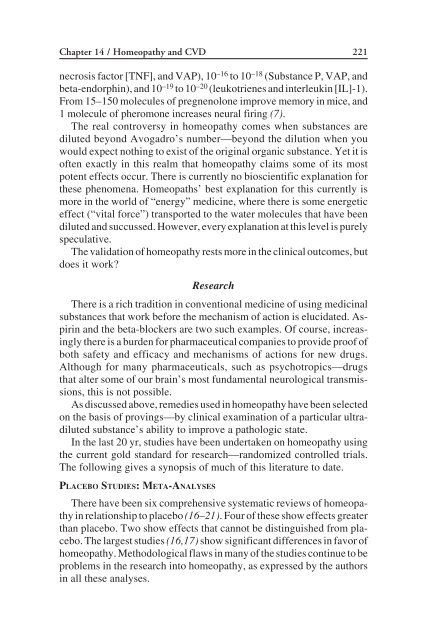Complementary Alternative Cardiovascular Medicine
Complementary Alternative Cardiovascular Medicine
Complementary Alternative Cardiovascular Medicine
You also want an ePaper? Increase the reach of your titles
YUMPU automatically turns print PDFs into web optimized ePapers that Google loves.
Chapter 14 / Homeopathy and CVD 221<br />
necrosis factor [TNF], and VAP), 10 –16 to 10 –18 (Substance P, VAP, and<br />
beta-endorphin), and 10 –19 to 10 –20 (leukotrienes and interleukin [IL]-1).<br />
From 15–150 molecules of pregnenolone improve memory in mice, and<br />
1 molecule of pheromone increases neural firing (7).<br />
The real controversy in homeopathy comes when substances are<br />
diluted beyond Avogadro’s number—beyond the dilution when you<br />
would expect nothing to exist of the original organic substance. Yet it is<br />
often exactly in this realm that homeopathy claims some of its most<br />
potent effects occur. There is currently no bioscientific explanation for<br />
these phenomena. Homeopaths’ best explanation for this currently is<br />
more in the world of “energy” medicine, where there is some energetic<br />
effect (“vital force”) transported to the water molecules that have been<br />
diluted and succussed. However, every explanation at this level is purely<br />
speculative.<br />
The validation of homeopathy rests more in the clinical outcomes, but<br />
does it work?<br />
Research<br />
There is a rich tradition in conventional medicine of using medicinal<br />
substances that work before the mechanism of action is elucidated. Aspirin<br />
and the beta-blockers are two such examples. Of course, increasingly<br />
there is a burden for pharmaceutical companies to provide proof of<br />
both safety and efficacy and mechanisms of actions for new drugs.<br />
Although for many pharmaceuticals, such as psychotropics—drugs<br />
that alter some of our brain’s most fundamental neurological transmissions,<br />
this is not possible.<br />
As discussed above, remedies used in homeopathy have been selected<br />
on the basis of provings—by clinical examination of a particular ultradiluted<br />
substance’s ability to improve a pathologic state.<br />
In the last 20 yr, studies have been undertaken on homeopathy using<br />
the current gold standard for research—randomized controlled trials.<br />
The following gives a synopsis of much of this literature to date.<br />
PLACEBO STUDIES: META-ANALYSES<br />
There have been six comprehensive systematic reviews of homeopathy<br />
in relationship to placebo (16–21). Four of these show effects greater<br />
than placebo. Two show effects that cannot be distinguished from placebo.<br />
The largest studies (16,17) show significant differences in favor of<br />
homeopathy. Methodological flaws in many of the studies continue to be<br />
problems in the research into homeopathy, as expressed by the authors<br />
in all these analyses.


